Unit 2
Satellite sub-systems
As there is a gravitational force from the sun and moon there are some chances that the satellite may deviate from its orbit. The Attitude and Orbit Control systems keep the antennas to point towards the earth. The above system can be classified as
Attitude control system
In this control technique, the satellite in its orbit is observed. This can be achieved by spinning the satellite or by three axes method. Both of these methods are discussed below in detail.
a) Spinning: The body of the satellite is rotated around its spin axis in this method and the rotation produces a gyroscopic force at 30-100rpm. This rotation makes the satellite point in the same direction and makes it stable. Such satellites are called spinners. A drum of cylindrical shape is placed inside a spinner which is covered with solar cells. The drum also consists of rockets and power systems. The drum has a communication subsystem on its top which is driven by an electric motor. The direction of rotation of the motor is opposite to the rotation of the satellite body. The satellite with such operations is called as de-spin.
b) Three-Axis Method: In this method, the orientation of the satellite is controlled by the axes. There is no need to rotate the main body of the satellite. There is a roll axis that is in the same direction as the satellite in the orbital plane. The yaw axis is directed towards the earth. The pitch axis is perpendicular to the orbital plane.

Fig 1 Three-axis positions
The above-mentioned axes define the altitude of the satellite. This set of three-axis provides information about the orientation of the satellite with respect to reference axes. If there is a change in altitude of the satellite, then the angles between the respective axes will be changed.
There are two gas jets to provide rotation in both directions of the axes. The first gas jets make sure that the satellite has its motion in a particular direction. The second jet operates when the satellite reaches its desired position.
Orbit control systems
As many other forces are acting in space which may deviate satellite from its orbit the orbit control system takes care of this. It helps to monitor and bring the satellite back to its position. The TTCM systems monitor this from earth stations. The LEO and MEO satellites also need AOC systems to maintain the correct orbit and attitude for continuous communication.
The TTC&M systems are important for the successful operation of communication satellites. The main function of satellite management is to control the orbit and attitude of the satellite, monitor the status of all sensors and subsystems on the satellite.
Telemetry and Monitoring System
The main aim of this system is to collect data from sensors that are present within the satellite and send them to controlling earth stations. There are many sensors on a satellite monitoring fuel level, temperature, voltage-current, etc. The telemetry system sends the sensor data, the status of each subsystem, the position of switches back to the earth.
The telemetry data are sent using PSK phase shift keying. At the earth station, there is a low data rate receiver as there are thousands of bits transmitted. The data rate is normally low so that narrow bandwidth is maintained and to have a high carrier to noise ratio.

Fig 2 TTC&M system
Tracking
For knowing the current orbit and position of satellite tracking systems are used. The telemetry downlink with the satellite control centre check for status for the space segment space station. The range and the look angle are tracked by the tracking systems on the earth station. The velocity and acceleration sensors are helping to calculate the change in the orbital position of the satellite. The tracking subsystem on earth tracks the satellite after its last stage of launch. The initial orbit of the satellite and the transfer orbit is tracked by the tracking system at the earth substation.
Commanding
To launch the satellite in proper orbit and to monitor its function in that orbit we need commanding subsystems. Whenever the attitude and orbit of a satellite have deviated these systems are responsible for adjusting them. It is responsible for turning ON / OFF of other subsystems present in the satellite-based on the data getting from telemetry and tracking subsystems.
The control words are converted to command words which are sent through TDM frames. The satellite checks for the correctness of these command words and then sends them to the earth station. The earth station again checks these command words if they are correct the execute signal is sent to the satellite.
Key takeaway
The Telemetry system transmits the satellite information to the earth station and in the commanding system, the satellite receives a command signal from the earth station.
All communication satellites obtain their electrical power from the solar cells. The sun is a powerful source of energy. Solar cells do not convert all the incident energy into electrical energy only 20-25% is its efficiency. The three-axis stabilized satellites can make better use of solar cells. As the cells can be rotated to maintain the normal incidence of sunlight. The satellites must have batteries to provide backup during a solar eclipse as it occurs twice a year.
The design of satellite communication is a complex process. The satellite weight is one of the factors which is looked after during the design. The weight mainly increases due to the amount of fuel it carries and the number of transponders in it. The frequency band used multiple access techniques and atmospheric propagation affects the design of the satellite.
The LEO and MEO require more satellites than GEO. The bit error rate (BER) in digital signal and S/N ratio in an analog link is maintained to the best possible values. The baseband channel (where the information-carrying signal is generated) or S/N ratio is determined by the carrier to noise ratio at the input to demodulator. In a noiseless receiver, the C/N ratio is constant at all points.
There are two satellite links uplink (from earth to satellite) and downlink (from satellite to earth). The overall C/N ratio depends on both the links. Due to heavy rain on the earth, the path attenuation may become more making the C/N ratio to fall below the permitted values.
Key takeaway
The parameters like the performance of uplink and downlink, propagation characteristics, and rain attenuation for frequency band being used are to be monitored.
The basic requirement for satellite communication is the amount of power received by the earth station from the satellite.
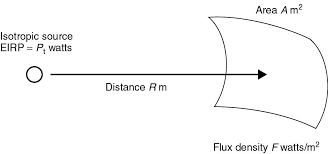
Fig 3 Flux Density by Isotropic Source
Let us consider an isotropic source transmitting in free space which is radiating the total power of Pt. At distance R from that source flux density crossing the surface is
F = 
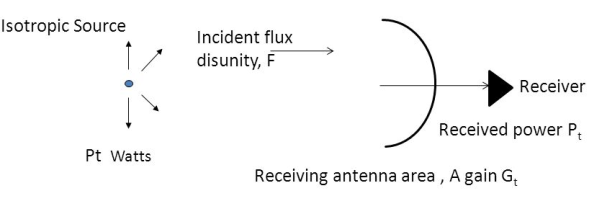 Fig 4 Power received by the ideal antenna
Fig 4 Power received by the ideal antenna
For a transmitter, without power Pt driving the lossless antenna with gain Gt the flus density at distance R will be
F = 
The product term PtGt is called Effective isotropic radiated power (EIRP). This EIRP is the combination of transmitting power and antenna gain in terms of an equivalent isotropic source having power PtGt. An ideal receiving antenna with aperture A will collect power
Pr= F*A
The effective aperture is given as Ae =  A
A
 = Aperture efficiency of the antenna (50-75% for parabolic and 90% for horn antennas)
= Aperture efficiency of the antenna (50-75% for parabolic and 90% for horn antennas)
Now the power received by a real antenna with effective aperture Ae is given as
Pr=  (1)
(1)
The gain of the antenna is given as
G = 
From 1 we have
Pr= 
The above equation is called a link equation. The term  is called path loss LP. The power received can also be written in dB as
is called path loss LP. The power received can also be written in dB as
Pr= EIRP +Gr-LP (2)
The above equation represents the ideal case with no losses in the link.
EIRP = 10log10(PtGt)
Gr = 10log10( )
)
LP = 10log10( )2
)2
But practically many other losses need to be taken count of such as attenuation by oxygen, water vapour, rain, or losses in antennas at the end of links. The above equation then changes to
Pr= EIRP +Gr-LP – La – Lta -Lra
Where:
La = attenuation in atmosphere
Lta =Losses due to transmitting antennas
Lra =Losses due to transmitting antennas
Key takeaway
The satellite links use frequency modulation for analog transmission or phase modulation for digital systems. In both techniques, the amplitude of the carrier is not changed when data are modulated onto the carrier.
Noise Temperature
In satellite communication, we have to deal with weak signals. As the signals are weak due to the distance and disturbances in space it is always required to keep the noise levels low. As there are active and passive elements used in the satellite system the noise temperature in the receiver can be known to get an idea of the thermal noise present. Any black body with a temperature Tp degree kelvin will produce electrical noise. The noise power is given by
Pn = kTpBn
k = Boltzmann constant (1.39 x 10-23) J/K
Bn = noise bandwidth
The system noise temperature Ts is the noise temperature of the noise source which is present at the input of the noiseless receiver. This noiseless receiver will give the same noise power as the original receiver which will have noise from the antenna as well.
Calculation of system noise temperature
Below shown is the figure of the simplified receiver which has an RF amplifier and single frequency conversion from the RF input to the IF output. These receivers are superheterodyne. The low noise amplifiers are the RF amplifiers that introduce noise in the receivers.

Fig 5 Simplified earth station receiver
The equivalent circuit for noise calculation is shown below. The noiseless blocks are used instead of noisy devices. These blocks have some gain and noise generators at the output also so that they produce the same values at the output as well.


Fig 6 Equivalent noise source
The total noise power at the output of the receiver will be
Pn = GIF k TIF Bn + GIF Gm k Tm Bn + GIF Gm GRF k (TRF + Tin) Bn (3)
Where:
GIF Gm GRF = Gain of IF amplifier, mixer, and RF amplifier.
TIF Tm TRF = Equivalent noise temperature of IF amplifier, mixer, and RF amplifier.
The above equation can be also written as
Pn = GIF Gm GRF k Bn [TRF + Tin + Tm/GRF + TIF/ (Gm GRF)] (4)
Same noise power can be generated by a single noise source at the output.
Pn = GIF Gm GRF k Ts Bn (5)
Equating 4 and 5
Ts = [TRF + Tin + Tm/GRF + TIF/ (Gm GRF)] (6)
The equivalent noise model shows the output noise temperature of Tno
Tno = Tp (1-G1)
Noise Figure and Noise temperature
The noise figure is defined as
NF = (S/N)in/(S/N)out
The noise figure in terms of noise temperature is defined as
T = T0 (NF-1) (7)
G/T ratio
The equation for G/T ratio is given as
 =
= 

Key takeaway
The noise figure in terms of noise temperature is defined as
T = T0 (NF-1)
The equation for G/T ratio is given as
 =
= 

Design of downlink
The satellite needs a downlink and uplink for communication as we already know. During design, the C/N ratio is of major concern. The atmospheric conditions such as rain, eclipse affect the transmission. The basic parameters to be noted for the design of the downlink are
The link budgets are an important part of the design. They make the task easy as once a link budget is calculated it is easier to change any parameter and then again calculate the result. For each transponder, the link budget should be calculated and then repeated for individual links. There are four links for two-way communication systems. Link budgets are calculated when the link has a lower C/N ratio. The link budget depends on the following two parameters.
The calculation of carrier to noise ratio in satellite link is represented by
Pr= EIRP +Gr-LP – La – Lta -Lra
The noise power is given by
Pn = kTpBn
The receiving system noise is written as
N = k+Ts+Bn
The losses like feeder loss occur in connecting waveguides, filters, etc. There can be lost due to misalignment of the antenna called a pointing loss. As a first step in the loss calculations, the power loss resulting from the spreading of the signal in space must be determined.
In the C band and, more especially, the Ku band, rainfall is the most significant cause of signal fading. Rainfall results in attenuation of radio waves by scattering and by absorption of energy from the wave. Rain attenuation increases with increasing frequency and is worse in the Ku band compared with the C band. This produces depolarization of the wave; in effect, the wave becomes elliptically polarized. This is true for both linear and circular polarizations, and the effect seems to be much worse for circular polarization
Design of Uplink
The satellite link in which the transmission takes place from the earth station to the satellite. The design of the uplink is easier than the downlink in many cases. The frequency-dependent losses like free space losses are calculated for uplink frequency.
The analysis of the uplink requires the calculation of the power level at the input to the transponder so that the uplink C/N ratio can be found. When the C/N ratio is specified for the transponder the calculation for the required power to be transmitted becomes easier.
For frequencies above 10GHzthere are disturbances in the form of fading. The rain causes to power level at the satellite to reduce below the permissible levels. Due to this, the C/N ratio at the transponder reduces, which in turn reduces the overall C/N ratio. The uplink power control can be used to overcome rain attenuation.
If the downlink attenuation is scaled it becomes easier to estimate for uplink. The uplink attenuation is given by
Aup = Adown x(fup/fdown)2
Due to rain, the link between earth and satellite is affected. The uplink C/N ratio in the transponder falls until UPC starts to operate.
Key takeaway
For frequencies above 10GHzthere are disturbances in the form of fading. The rain causes to power level at the satellite to reduce below the permissible levels. Due to this, the C/N ratio at the transponder reduces, which in turn reduces the overall C/N ratio. The uplink power control can be used to overcome rain attenuation.
The uplink (C/N)up ratio in the transponder and the downlink (C/N)down in the earth station is necessarily calculated. Mostly the C/N values are calculated from power and noise budgets they are in dB.
The rain attenuation affects uplink and downlink in different manners. When we calculate attenuation, we only consider one side either uplink or downlink. The attenuation that can occur simultaneously on both sides at the same time is not considered.
Uplink attenuation and (C/N)up
The rain attenuation in the uplink reduces the power at the satellite input receiver. For linear transponder and rain attenuation in the uplink for the linear transponder is given by
(C/N)0uplink rain = (C/N)0 clear air – Aup
For the downlink, the transponder is given by
(C/N)0uplink rain = (C/N)0 clear air – Aup +  G
G
For regenerative transponders
(C/N)0uplink rain = (C/N)0 clear air
Downlink attenuation and (C/N)down
The noise temperature at the earth station changes fast due to rains in the downlink path. There is an increase in the sky noise temperature which causes the received power level to decrease and noise power to increase. The C/N for the downlink is given by
(C/N)downlink = (C/N)downlink clear air – Arain -  Nrain
Nrain
The overall C/N is given by
(C/N)0 = 1/[1/(C/N)down rain + 1/(C/N)up]
Key takeaway
The rain attenuation affects uplink and downlink in different manners. When we calculate attenuation, we only consider one side either uplink or downlink. The attenuation that can occur simultaneously on both sides at the same time is not considered.
The satellite needs consideration at the data link control layer of the operation standards. In most satellites, MAC schemes are assigned in time and frequency. Some are discussed below
FDMA
- It sub-divides frequency into several frequency bands with non-overlapping.
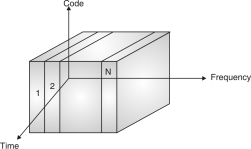
Fig. 7 FDMA
- FDMA allows users to transmit signals simultaneously to satellite transponder with the help of assigning a specific frequency to every user among a channel.
- Each transaction of the signal has its unique radio channel. Channel is probably 30 kHz or less used to transmit or receive channels.
- Frequency allocation made by national policies. Uplink (i.e. from mobile station to base station). The downlink (i.e. from the base station to mobile station) uses frequency bands like. Uplink and downlink with frequencies mentioned below :
Uplink | 890.2 MHz, 915 MHz |
Downlink | 935.2 MHz to 960 MHz |
Uplink (UL) and downlink (DL) can be described with the help of one relation among them as follows:
fd=fu + 45 MHz
- For Example :
If UL frequency is :
fu = 890 MHz + n∙ 0. 2 MHz
Then
fd = 935 MHz + n ∙ 0. 2 MHz
- Fixed assigned frequency makes scheme very inflexible limits to no. Of sender turn into the disadvantage of FDMA.
TDMA
- It is based on time slots. TDMA is more flexible than the FDMA scheme.
- Dynamic allocation of channel or by some fixed pattern channels get allotted for time slots to takes places synchronized communication.
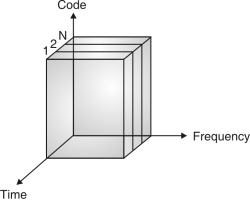
Fig. 8 TDMA
- Fixed channels are allocated for communication as best practice solution for the wireless phone system in Medium Access Control (MAC) reserved time slot access is crucial.
CDMA
- CDMA stands for Code Division Multiple Access. CDMA is a technique for spread spectrum multiple access.
- Data signals are XOReD with pseudorandom code and then transmitted over a channel.
- Different codes are used to modulate their signals, selection of code to modulate is an important aspect as it relates to the performance of the system.
- In CDMA, single-channel uses entire bandwidth and it does not share time as all stations transmit data simultaneously. Due to this CDMA differ from FDMA and TDMA.
- Let us assume we have 4 different stations A, B, C, and D. All 4 stations connected to the same channel. Data from station A is d1, B is d2, C is d3 and D is d4 similarly code assigned to A is C1, B is C2, C is C3 and D is C4.
- To transmit data, all 4 stations have a multiplication strategy i.e. either code multiplies by itself. It results in 4 stations or code multiply results in 4 stations or code multiply results in 4 station of code multiply by another, it results in zero station.
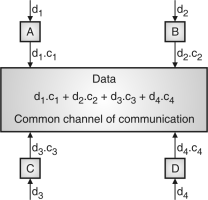
Fig. 9: Communication of station with code
- If station C and station D are talking to each other, D wants to listen to whatever C is saying. It multiplies data on a channel by C3 of station C.
- As C3 C3 is 4 and rest of combination i.e. C1 C3, C2 C3 and C4 C3 are all zero.
- Every station has some code, which is a sequence of numbers known as chips.
- The sequence should be selected appropriately to get appropriate codes. The orthogonal sequence has some properties :
- Multiplication of sequence by a scalar.
- The inner product of two equal sequences.
- The inner product of two different sequences.
- Sequence generation uses the Walsh table to generate a chip sequence.
Multiple Access for Radio Packet Systems: Pure ALOHA

Fig.10: Classical ALOHA
- Above random access scheme no central control access, no co-ordination occur in stations.
- When more than two stations are accessing medium, a collision takes place.
Slotted ALOHA
- It is a refinement of the classical aloha scheme. All senders are synchronized and transmission takes place at beginning of the time slot.
- It provided time slots additionally to classical aloha so-known as slotted aloha.
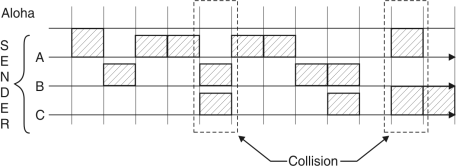
Fig.11 Slotted ALOHA
PRMA
The packet reserved multiple access combines TDMA and S-ALOHA. In this when an ES has received a slot the packet is called safe packets and unsafe data is sent when new ES tries to establish a channel.
VSAT
They are star-based topology networks called a very small aperture terminal (VSAT). The transmitter or receiving antenna on the satellite link should be larger. These networks are ideal for centralized networks. The signal which is weak from ES is amplified by satellite and then received by the hub ES. Two hopes are required when two VSATs communicate. Normally S-ALOHA and TDMA are used as VSAT schemes.
Direct PC Service
These schemes need IBM compatibility with higher processors. They have an ISA card and RF antenna. A process like demodulation decoding and de-multiplexing is carried out in the card. The asynchronous transfer mode (ATM) provides quality of service. The single-bit errors are detected and corrected by the header error control. The mobile satellite service is the future of modern satellite networks.
Key takeaway
They are star-based topology networks called a very small aperture terminal (VSAT).
The single-bit errors are detected and corrected by the header error control.
Reference:
1. Merrill I. Skolnik “Introduction to Radar Systems”, Mc Graw- Hill.
2. J.C.Toomay, Paul J. Hannen “Principles of Radar”, PHI Learning.
3. B.Pratt, A.Bostian, “Satellite Communications”, Wiley India.
4. D. Roddy, “Satellite Communications”, McGraw-Hill Education.